
This fabulous dragon 'tank' comes from another volume out of the (very) weird baroque series - 'Frauenzimmer Gesprechspiele' [by GP Harsdoerffer] from HAB - that was featured here a few weeks ago.
For some reason, I got it into my mind that this engraving would be the first of many quasi-'biological tank' illustrations for a thematic entry - as if this was a hitherto secret and bizarre historical art genre (?!) - to be uncovered with a few choice image searches. Alas, the quest was largely unsuccessful, apart from the armoured war elephant image below [source]. Maybe I should have been concentrating the hunt in CG art forums. They certainly make great spaceships [via/via]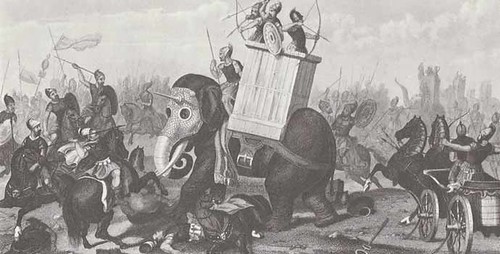

'Prognosticon Historicum und Physicum..' by Johann Hebenstreit, 1565 (at BSB). There are no other illustrations as I recall. This book belongs to the Renaissance symbolist prophecy literature.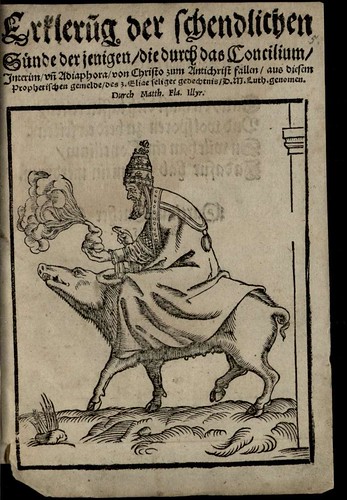
~1550 by the Lutheran Reformer, Matthias Flacius* [BSB].
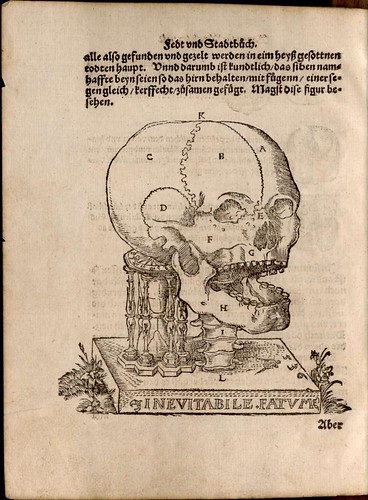
'Stat, und Feldtbuch Bewerter Wundtarznei' by Walther Hermann Ryff, 1551 [BSB]. This is a field manual of surgery and the skull-sundial image offers an introductory visual metaphor announcing the inevitability of death. There are many more images of instruments, surgery and anatomy within but I wouldn't describe the book illustrations as exceptional. Ryff was a prolific and respected author of 16th century medical texts. [see Morbid Anatomy for some further anatomical illustrations from another of Ryff's works]

"These series of publications, under the general title 'Allgemeine Naturgeschichte der Fische', Berlin, 1781-95, 12 vols., provided with 432 excellent plate-illustrations, formed the principal work on ichthyology in the eighteenth century. But this great work, which Bloch began to publish at his own expense, would not have been finished were it not for the enthusiasm that the enterprise roused throughout Germany, it being regarded as almost a national affair; so much so indeed that all the princes and patrons of science participated in the publication expenses of the last six volumes, each plate bearing the name of the person at whose cost it had been prepared."The plate above comes from the Rylands Collection at the University of Manchester.
The complete or near complete series is available from the Internet Archive.
Update: alternatively, the University of Heidelberg have uploaded plates from the original German version of this work (curiously, I can't find the above image): LINK.
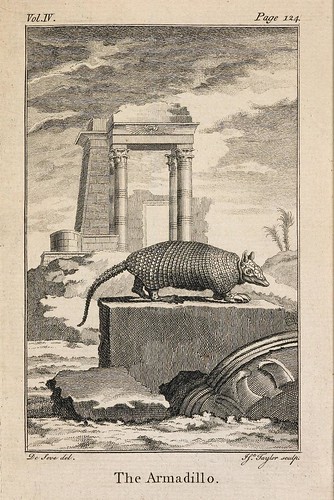
"Oliver Goldsmith's 'An History of the Earth and Animated Nature' [1774] has been described as everything from "hackwork" to his "most substantial literary legacy"." [source] Heh. I think I would be happy to leave behind a legacy that inspired such a broad reaction. The armadillo plate comes from Rylands.
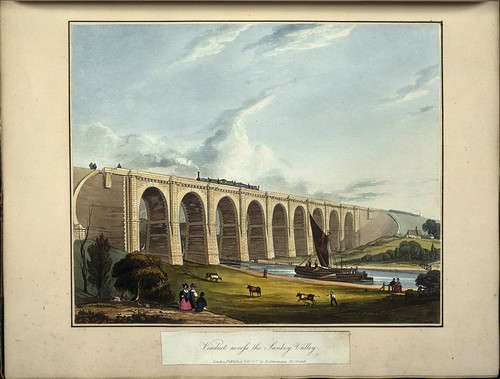

I had read about 'Coloured Views on the Liverpool and Manchester Railway' by Thomas Talbot Bury (1831) which was how I came to be ferreting about in the Rylands Collection in the first place. The book was published in many editions with varying numbers of aquatint plates, but as far as I can tell, the full work has not been digitised. [see here and here]
"The Liverpool and Manchester Railway opened September 15, 1830, and was the first to use locomotive power wholly as a form of traction. The 31-mile journey took an hour and a half and cost 5/. It was a great success and spurred construction of railroads in England and abroad. The locomotive engine was designed by George Stephenson, who won a £500 prize. The artist, Thomas Bury, was a noted architect."
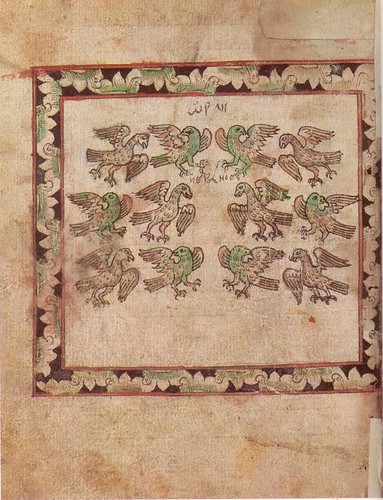
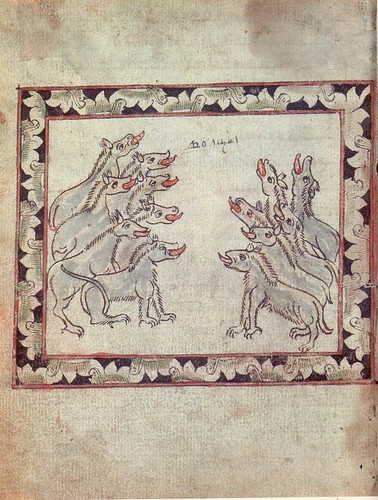


(The Tale of the Rout of Mamai)
These unusual and interesting Russian manuscript illustrations come from a rare 17th century work held in the State Historical Museum* in Moscow. Scans of the manuscript were posted on the babs71 Livejournal page.
The British Library have a different version (Yates Thompson 51) with all the page images available:
"The Skazanie is a romance, composed in the 15th century, relating the struggle of the Muscovian Grand Prince, Dmitri Donskoj, against his Tartar opponent, Mamai. The central focus is the battle of Kulikovo (1380) at which Mamai was routed. The victory is presented in the context of a crusade and is couched in terms reminiscent of the contest between Gideon and the Midianites (Judges 7)."
History of Kulikovo Battle: "The Kulikovo battle of 1380 is the most important event in the history of the Medieval Russia, which to a great extent defined the further destiny of the Russian State. The battle on the Kulikovo field commenced the North-West Russia liberation from the Yoke of the Golden Horde." [also]{thanks to languagehat for translation and background help ---- incidentally, languagehat is the co-author of 'Uglier Than a Monkey’s Armpit - Untranslatable insults, put-downs and curses from around the world': publisher; AmazonUK}

This is my idea of found type: the 1870 sheet music cover from Franz Liszt's 'Christus Oratorium' [from BSB] [image has been moderately background cleaned]

subscription ticket by William Hogarth, 1830.

This exquisite celtic knotwork illuminated letter 'b' from the late 10th century, comes from a latin vellum manuscript known as 'Evangelia Ottonis'. The notes at Rylands mention that it is possibly Italian in origin.

In between contributing to the popular fairy tales of the early 1800s that made the Brothers Grimm a household name, the younger brother, Wilhelm, published a book on German rune stones in 1821 called 'Ueber Deutsche Runen', available from SICD. [previously]
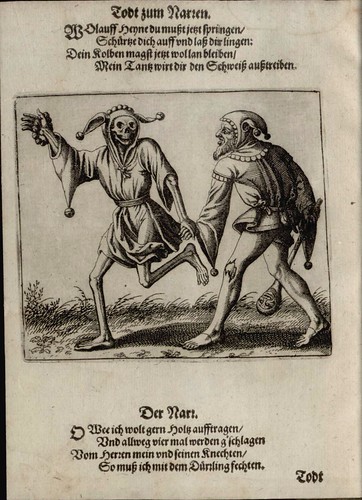
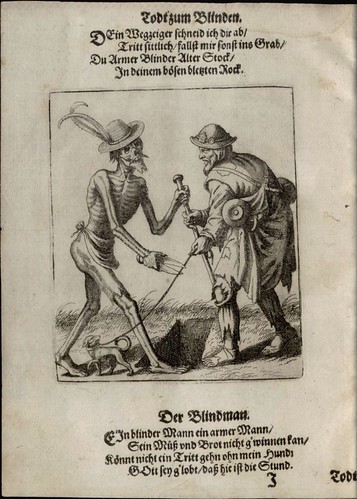
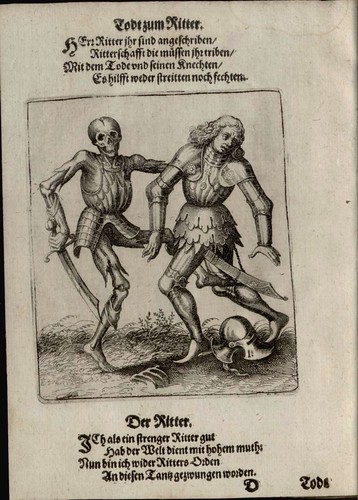
Murals of the dance of death (danse macabre or totentanz) scenes were painted on walls in a church and a convent in Basel in the early to mid-1400s. They are important examples of the tradition since they are the link back to its medieval origins and also because they served as the inspiration for the classic iconography produced by Hans Holbein the Younger in his 'Imagines Mortis', first published in 1527.
The murals were eventually destroyed and the most faithful reproductions of the figures in those scenes were said to have been engraved by native Basel artist, Matthäus Merian, for his 1621 book 'Todtentanz, Wie Derselbe..'. As far as I know, the first full version of this work was made available online recently by the Bavarian State Library.
[see previously: Totentanz Blockbook; Heidelberger Totentanz; Death Becomes Her; Death's Dance; and also Morbid Anatomy's recent post on Holbein (via).]


Engraving of Lucifer by Balthasar Caymox (Caimox) after Dante's 'The Divine Comedy' from the Virtuelles Kupferstichkabinett. The print is undated but judging from a previous illustration of his seen here, it was produced in the early 1600s. These images were spliced together from screencaps. [previously; also: see this Monster Brains post for more Dante devils from a 14th century Bodleian manuscript]
Other things...
- Raising Rebels: An Exhibition of Radical Children's Literature at Syracuse University Library.
- Although this will primarily be of interest to Czech readers, there is a collection of early 20th century periodicals available from the Institute of Czech Literature. They (apparently) cover a range of topics such as humour, theatre, art and design, with something of an avant-garde edge. There are illustrations/cartoons in there. I say apparently because, although it's fairly straight forward navigation, I haven't spent much time looking as yet. Full page images are available in greyscale.
- Building floorplans from 17th/18th century Baroque-Gothic Czech architect, Jan Blazej Santini-Aichel.
I don't remember where this link came from.[Thanks Karla!] There is a fair bit of english around on the site. - Old Book Art has scans of some unique books available.
- 'Multiple Choice: From Sample to Product': "Sample plates, cards of buttons, and textile and wallpaper swatches – in digitized form - are featured on the website for this exhibition from the collections of the Cooper-Hewitt, National Design Museum and Smithsonian Institution Libraries" [via]
- Many, many more links in the bookmarks.
- I always find the annotated BibliOdyssey delicious page is the easiest way to find things.
- Lately I've been saving shared feeds here.



















8 comments :
Does someone know what the script in the image tagged "wolves" is/says?
I think I sent you the two Czech links (what a surprise...), but the digitized periodicals page seems to have changed somewhat since I last looked. Suddenly I only seem to be able to get Zlatá Praha out of it... (then again maybe I'm doing something wrong as I HAVE A HEADACHE and can't think straight).
Well I've given you an attribution link on the ground plans. I thought I told you about the periodicals no? Eh. *shrug* You might be right about the content changing: when I checked back through emails some of your remarks didn't quite marry up with what was listed. I thought you had just been widening your commentary to related material. (that's the generous way of saying I didn't know what you were talking about)
/sideline talkfest
I don't know whether I was just brain-dead last night or whether something was screwy with the periodicals site. This morning it brought up the list just fine--go down below the big red message about the server and the "emergency regime," which may explain more than I think it does. (As for who found it first, well maybe you did as I don't remember how I learned about it, just that I've been using it for a couple of years now.)
For the non-Czech-readers, anything with "divadlo" or "divadel" in it relates to theater, Humoristické listy is worth a look, Světozor and Šibeničky have lots of pictures, Rozpravy Aventina was a cultural periodical and has lots of photos and cartoons scattered through. Some of the others are primarily text.
http://archiv.ucl.cas.cz/
The 1643 Popemobile from LOL Manuscripts! is another good example for your quasi-biological tank set.
Heh. Thanks Ray, good call.
i love that celtic book
and this conversation that followed
Dear Sean
Yes, your comment was deleted. This is because you decided to add a link to your site in the comment when your site has no relationship to this post.
I doubt that wearing night vision goggles and gobbling down a fistful of acid would help to establish any vague connection between your seven-odd token words, your link and the array of material in this post, but hey, maybe that's just me.
But don't be dissuaded from commenting: perhaps if you tried making some sort of actual contribution, adding some morsel of humour or some cogent observation, then the people who read down this far in the post would feel so moved by the light of your intellect that they would feel compelled to click on your user profile and follow you back to your homepage.
So unless a self-link is on-topic or contributes something of worth, it will be deleted.
This goes for anyone who wants to self-link to show that they are citing BibliOdyssey (unless it contributes something on-topic of value). There are a whole bunch of blog search engines out there through which I can find linkbacks. There is no need to make an announcement.
Because the next step is to turn comments off altogether.
Yours
P
Post a Comment
Comments are all moderated so don't waste your time spamming: they will never show up.
If you include ANY links that aren't pertinent to the blog post or discussion they will be deleted and a rash will break out in your underwear.
Also: please play the ball and not the person.
Note: only a member of this blog may post a comment.